Semester Project Presentations
6.S062 Mobile and Sensor Computing
Wednesday, May 11, 11am-12:30pm, 32-G9 Lounge
Wednesday, May 11, 11am-12:30pm, 32-G9 Lounge
On Wednesday, May 11, from 11am-12:30pm, the students of 6.S062 (Mobile and Sensor Computing) presented posters and demos of their semester projects in the G9 lounge.
Activity Recognition and Correction for Weight LiftingKatie Bartel, Kwame Efah |
Poster (PDF) Repo |
|
Weight lifting is an increasingly popular hobby. A key component to improving one's strength through weight lifting is meticulous record keeping of each workout. Additionally, many novice weight lifters injure themselves with poor form. We explore the potential of data collected from inertial measurement units (accelerometers and gyroscopes) fixed to a person's forearms to perform automatic record keeping of workouts, including: 1) recognition what weight lifting exercise a user has performed 2) counting of the number of repetitions performed 3) feedback on the user's form. We developed a pair of wearable, bluetooth capable sensor modules and a companion iOS app which performs the activity recognition, repetition counting, and form feedback. Combining the power of machine learning, sensor data, and mobile devices, our system makes weight lifting more accessible and safe for everyone. |
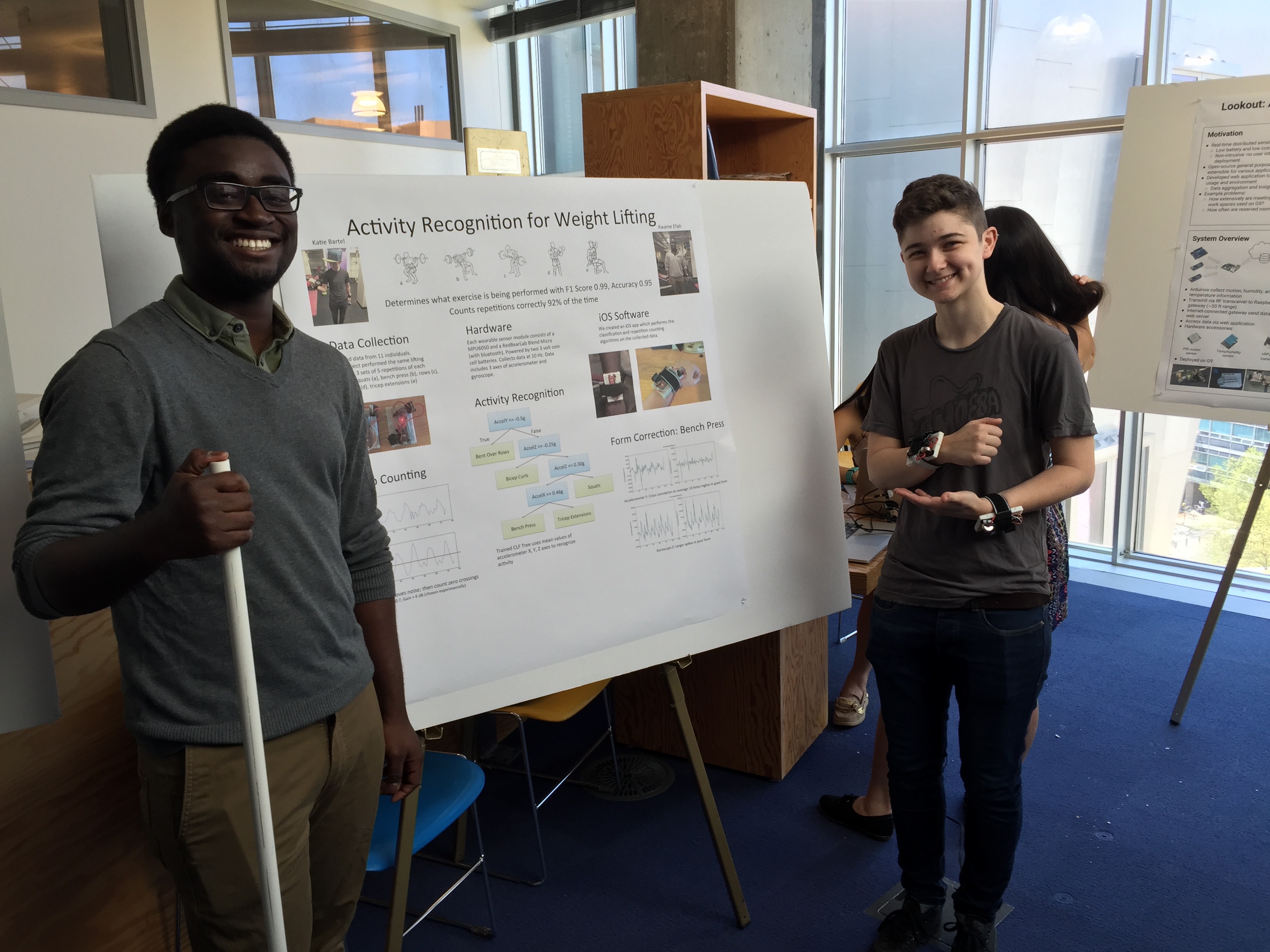
|
Verge, Estimated Time of Arrival for Pedestrian CommutesJorrie Brettin, Brendan Chang |
Poster (PDF) Repo |
|
As students, we have many responsibilities—so many that we inevitably find ourselves asleep well past the time we were supposed to wake up, late to class or an important meeting. In the process of rushing to your commitment in yesterday's clothes with unkempt hair, it would be nice to have an accurate estimate of your time of arrival. We developed an app which uses a combination of localization methods to give the user an accurate estimated arrival time to their destination. For the outdoor case, we use GPS to provide the user with the highest location precision available. When indoors, GPS doesn’t work; instead, we use a combination of dead reckoning and magnetic headings to estimate user trajectory. By integrating the two location services, we intend to give an accurate time estimate to users entering and exiting buildings on their way to a destination. |
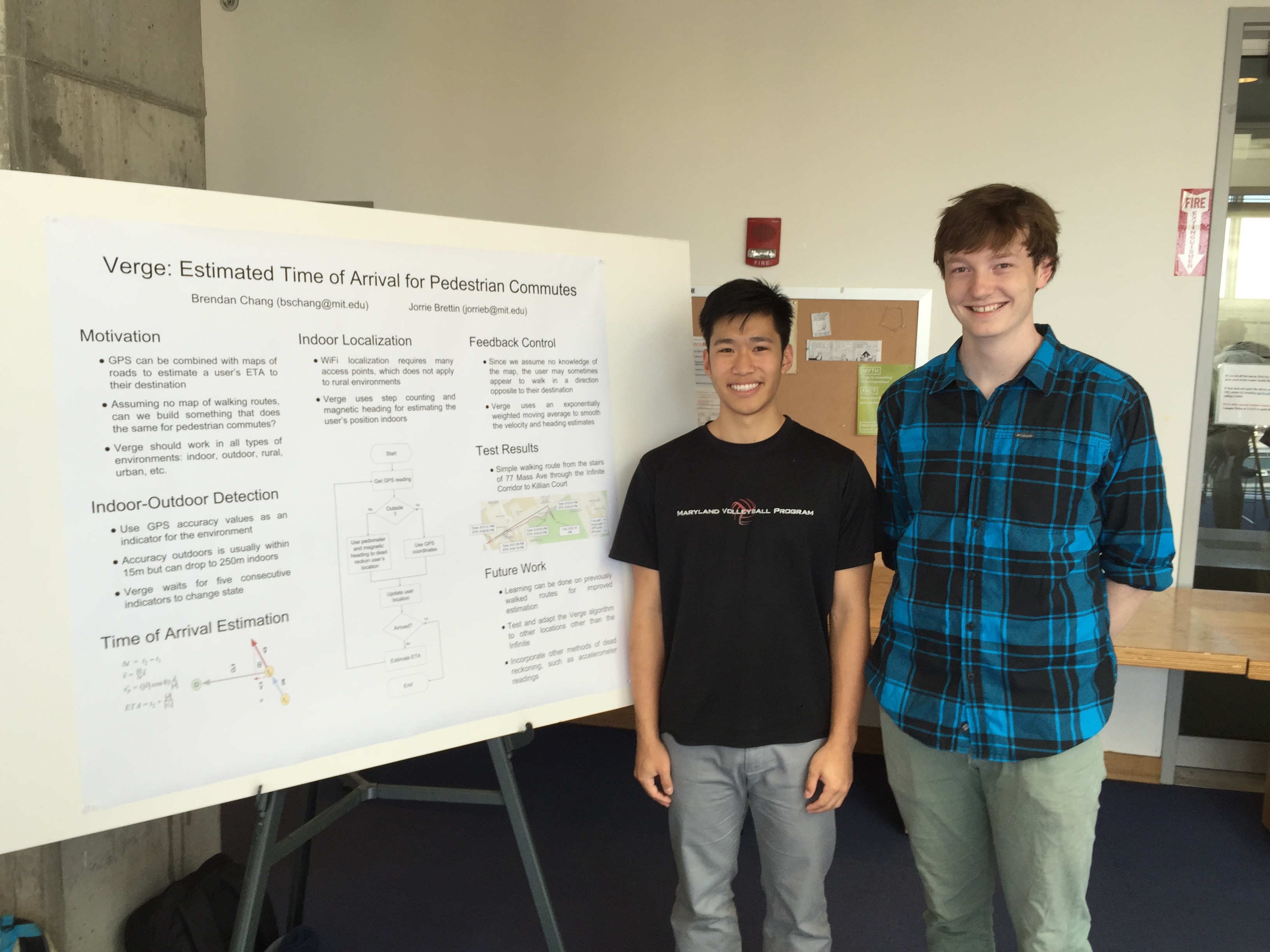
|
Gesture-Encrypted Location-Based MessagingDanny Callahan, Andrew Esquivel, Ryan Frankel, Harrison Wang |
Poster (PDF) Repo Repo Repo |
|
Many current existing applications allow individuals to post to message boards based on location. Though these solutions allow large quantities of people to communicate about activities or events ongoing in their location, they are largely anonymous in nature, cover relatively large areas, and do not necessarily allow individuals to communicate on a more personal basis. For these reasons, we developed a location-based, gesture-encrypted messaging application to allow individuals to send one another more targeted messages based on their locations. A user can send a message that is encrypted with a gesture. We chose to explore gesture encryption techniques to further understand how a gesture security system could be implemented. When another user comes within the proximity of this location, he or she is prompted to match the gesture. We break gestures into feature vectors, and perform fuzzy matching to determine whether or not the gestures match. In the event of a matched gesture, the message is released for the user to view. |
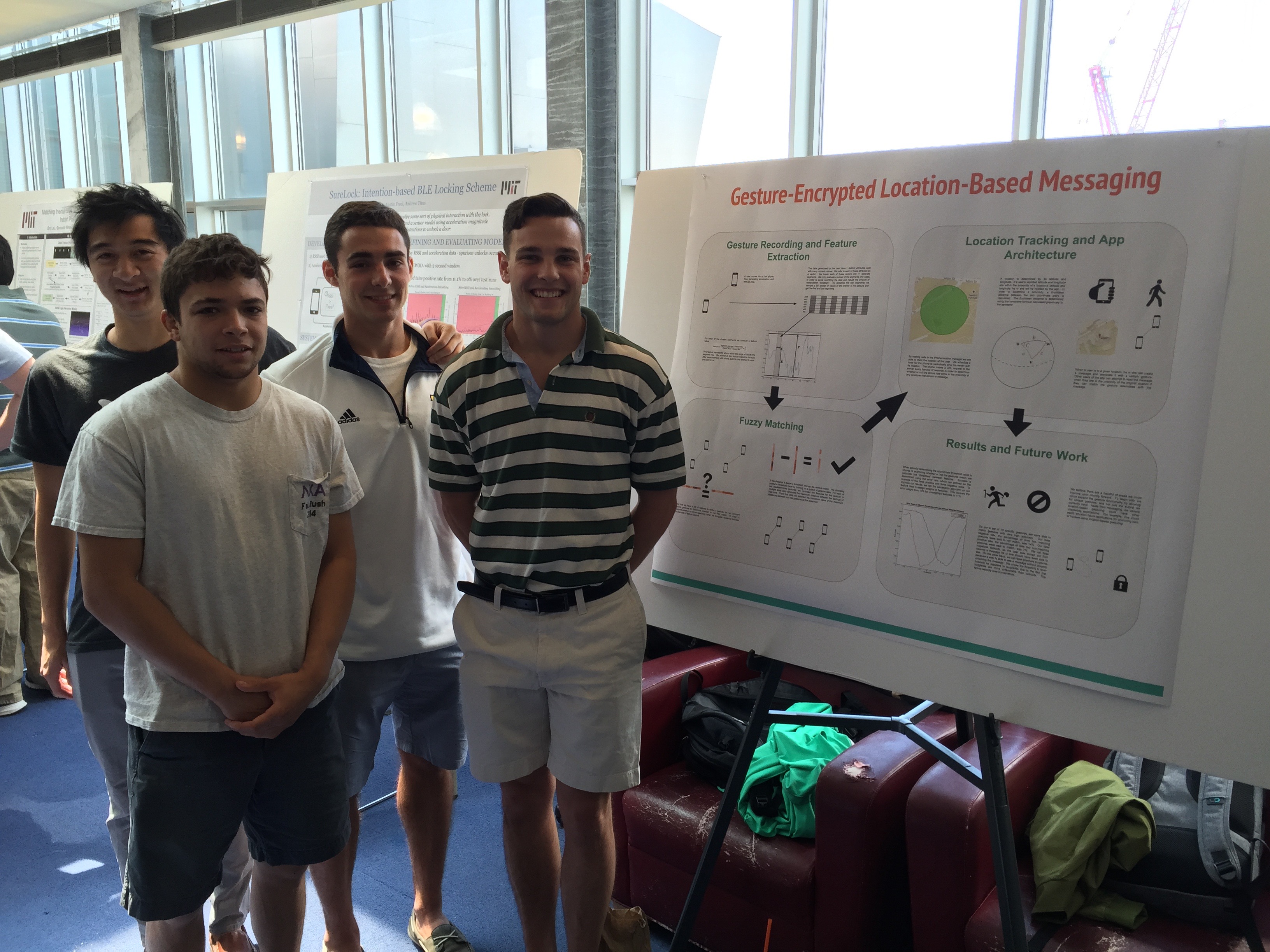
|
The MIT Tour-ing MachineNatasha Consul, Smriti Pramanick |
Slides (PDF) Repo |
|
Our project provides those that frequent MIT (students, tourists, etc.) an interactive and informative tool to learn about MIT’s rich history, such as hacks. We designed and developed an iOS application focusing on a tour of the Stata Center. The application provides a “museum tour” highlighting some major events that have taken place at MIT. Using a combination of different sensor technologies (BLE beacons and built-in phone sensors), we determine the exhibit the user is closest to and provide the user with relevant information. |
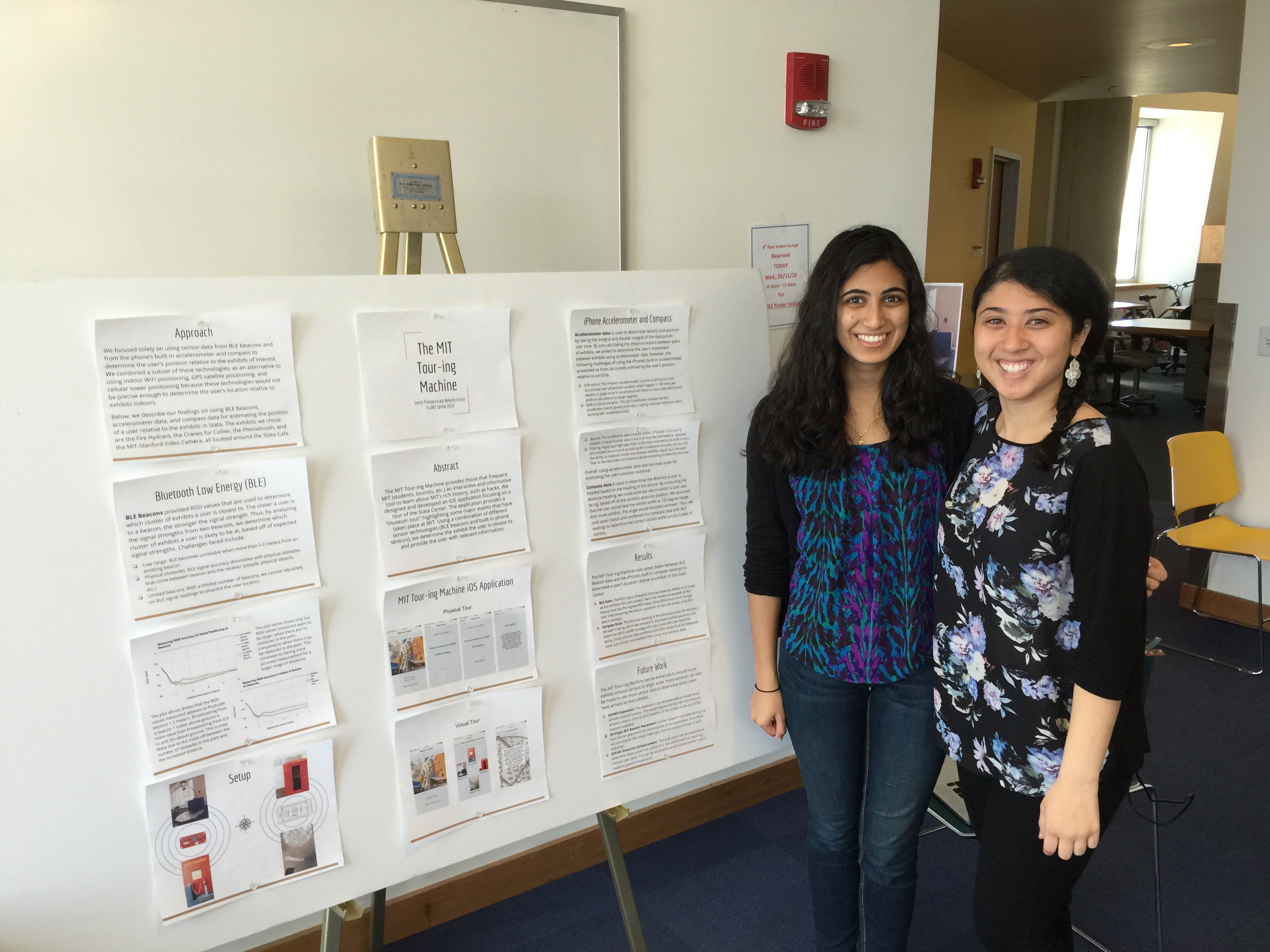
|
Collaborative Automated Collision Resolution for Self-Driving CarsDillon Dumesnil, Jordan Lucier, Alexander Nordin |
Slides (PDF) Demo Repo Repo |
|
In the not too distant future, self-driving cars will be a ubiquitous feature of society. We propose a project creating a system and protocol under which autonomous vehicles, such as self-driving cars, can communicate and work together to navigate their environment. Our project tackles the issue of resolving collisions between cars in a fair and efficient manner. We incorporated functionality for our cars to interact properly with pedestrians and high-priority vehicles, such as firetrucks and police cars. Our results will include a showcase featuring video of our cars safely resolving collisions with other cars and pedestrians as well as our RC cars and their modified hardware kits. |

|
SureLock: Intention-based BLE Locking SchemeAustin Freel, Andrew Titus |
Poster (PDF) Demo Repo Repo |
|
The vast majority of current door lock systems involve some sort of physical interaction with the lock. A hands-free system would require not only a sufficiently secure wireless credential transfer, but also accurate detection of a user’s intention to attempt an unlock of the door. We developed such a system using Bluetooth Smart 4.2 and a novel model using acceleration magnitude and RSSI data to detect a user’s intentions to unlock a door. We also propose a learning model to dynamically adjust the thresholds of this model to adapt to the specific environment of a given lock. |
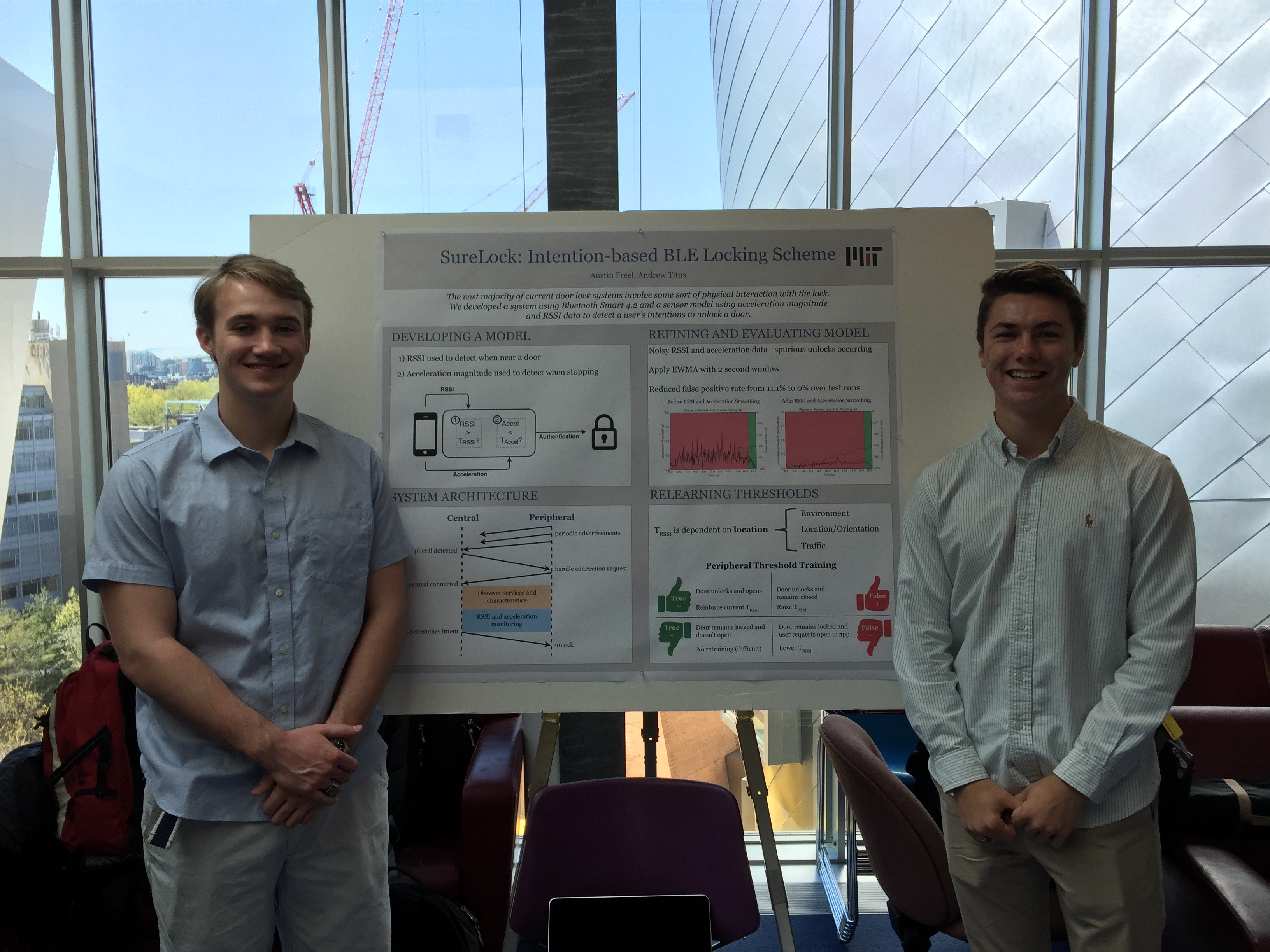
|
Air gesture recognizer on mobile devicesHayley Song, Chongyuan Xiang |
Slides (PDF) Demo Repo |
|
Currently, most users interact with their mobile devices on the screen via, for example, touch and scrolling. Consequently, many applications build accurate 2D handwritten digit recognizers. For our project, we aim to extend the scope to three dimension. We built an iOS application that recognizes 3D gestures while holding the mobile device. We use accelerometer data and make the prediction on a time sequence by applying k-Nearest-Neighbor algorithm on the training data with Dynamic Time Warping distance as the distance metric. We collected air gestures of 10 distinct alphabet letters (O ,I, J, L, Z, S, V, T, X, B) from 10 users, and select exemplary points from them for training purpose. Our accuracy results is on average 90.5% and the latency is 1-2 seconds per gesture. |
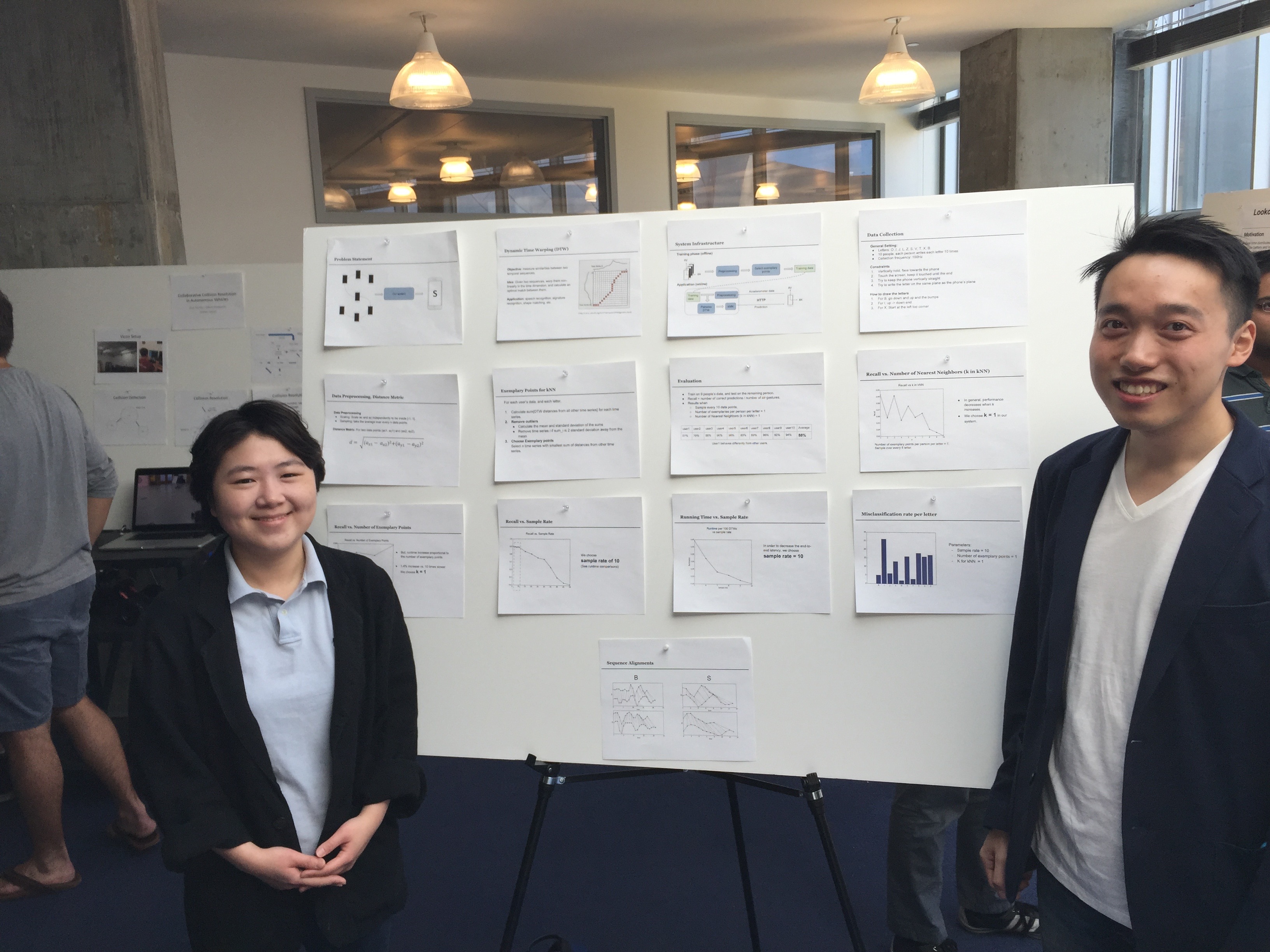
|
AirMuler: An Anonymous Data Muling FrameworkAnkush Gupta, Justin Martinez |
Slides (PDF) Repo |
|
Currently, frameworks for developing mobile applications that take advantage of multi-hop networks over Bluetooth Low Energy (BLE) are limited to networks that have a direct path from the source to the destination at the time of sending. Additionally, in traditional data muling applications, messages and sender/recipient information are regularly transmitted in plaintext. We have created an iOS framework that allows developers to create applications that can transport message across dynamic multihop networks which change over time, while eliminating the exposure of message contents and metadata to participating nodes in the multihop network. Our framework encrypts messages such that neither message contents nor sender/recipient identities are leaked as a result of transmission. Additionally, through the use of a unique ACKing protocol implementing a zero-knowledge proof, we are able to minimize retransmission once a message has been delivered, while still protecting the message contents and metadata. In conjunction with our framework, we have developed a simple multi-peer chat application illustrating a use case of AirMuler. |

|
Matching Inertial Logs to Video Tracking for Indoor PositioningEric Lau, Geronimo Mirano, Harihar Subramanyam |
Poster (PDF) Demo Repo Repo |
|
Suppose you own a shopping mall and you wish to provide users with a “Map” app, complete with “You Are Here” marker and informative advertisements of nearby attractions. Such a system requires precise indoor positioning, to a resolution which modern techniques such as GPS or WiFi localization cannot achieve. We present a novel system for indoor positioning which fuses overhead camera data with smartphone's inertial sensor to localize a user. The system tracks the trajectories of all people visible within the camera frame, then seeks to match the user’s inertial profile against the trajectories. The system is designed to be generalizable to any client with a smartphone; no pre-registration is required and user privacy is respected, both of which are improvements over a system which relies on visual recognition of users. We demonstrate a high fidelity vision processing system capable of tracking moving objects for many frames, then show our preliminary results matching inertial sense data against vision trajectories with high fidelity. |
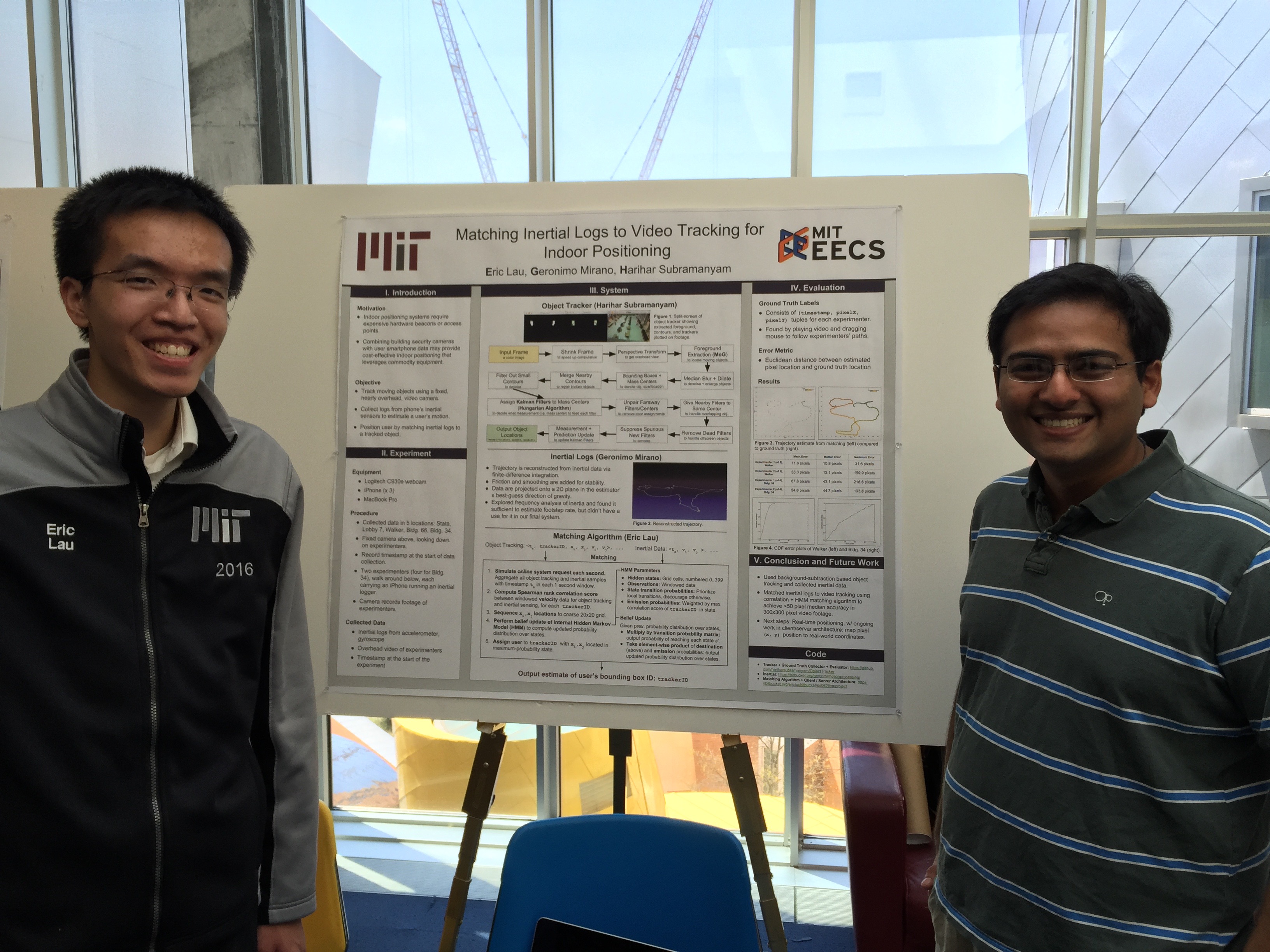
|
Lookout: A Distributed Sensing System for Arduino and Raspberry PiKatie Siegel, Rachel Wang |
Poster (PDF) Repo Repo Repo |
|
Lookout is a distributed sensing system that provides a cost-effective, easily deployable, and extensible platform to build applications using sensor data. The system has three components: sensing motes, a central gateway, and a remote server. Each mote collects data from various sensors and transmits readings through RF transceivers to a central Raspberry Pi gateway. The gateway forwards these readings to a cloud server via API POST requests. To make the system more efficient, we implemented and analyzed several optimizations for aggregating and filtering data on the server and the motes. Overall, the system’s general interface is easily compatible with other applications and different sensor types. We have developed an example application to monitor meeting rooms, which can provide information about their availability, the consistency between usage and the reservation system, and temperature regulation. |
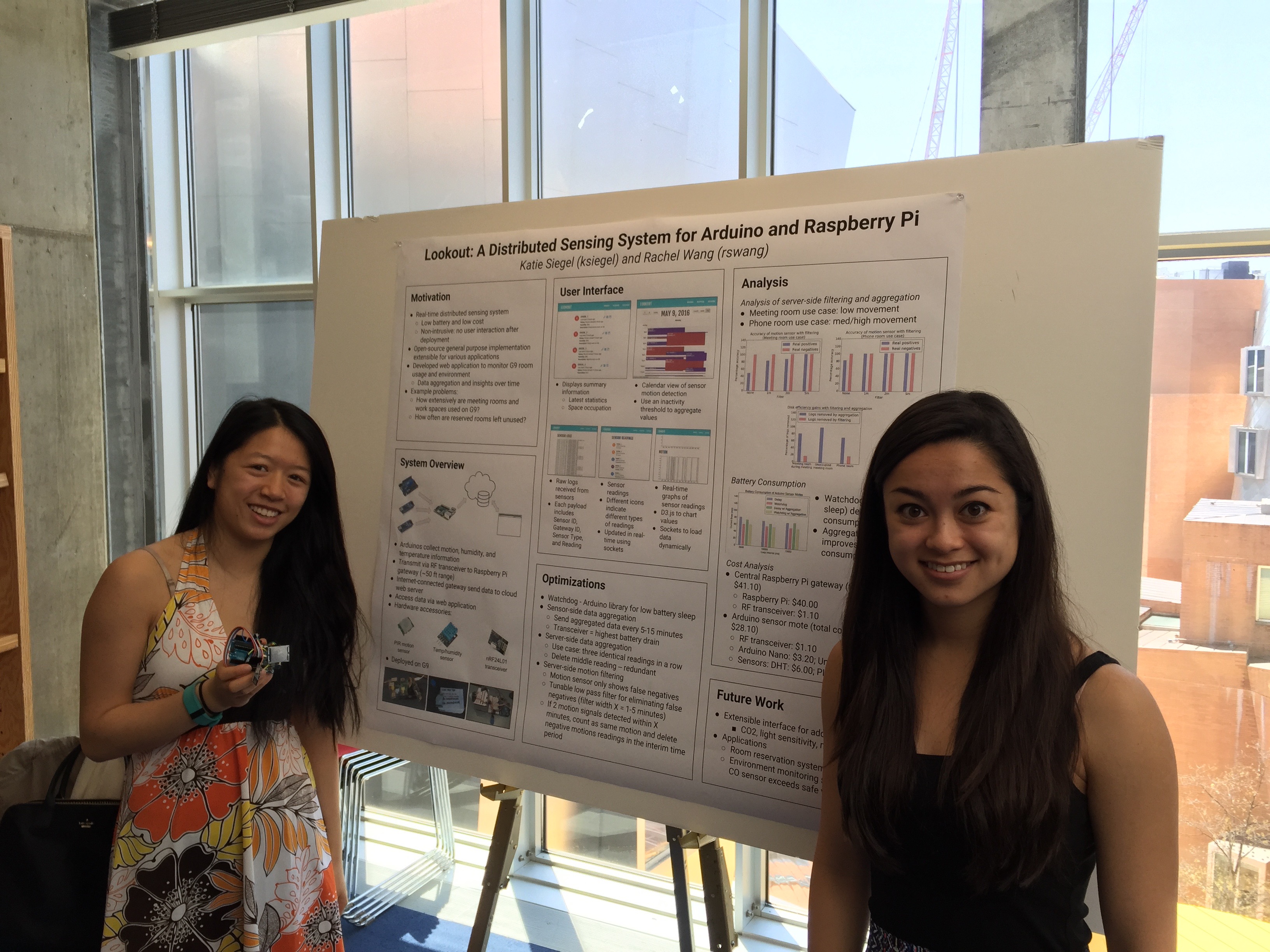
|
Images from the Noun project:
Barbell by Dara Ullrich
Shake Phone by Web Icon Set
Massachusetts Institute of Technology by NATAPON CHANTABUTR
Self-driving car by Jakob Vogel
entrance by Marc Andre Roy
Bump to Right by Web Icon Set
Donkey by Luis Prado
Tracking Location by Friedrich Santana
internet of things by Felix Westphal
PDF File by Laurent Canivet
Video by Milky - Digital innovation
Graph by Simple Icons